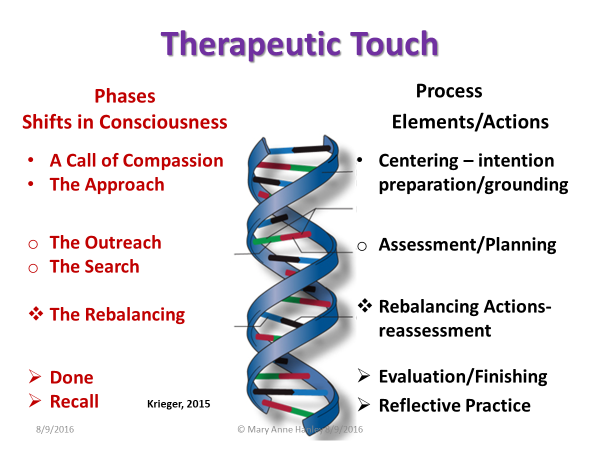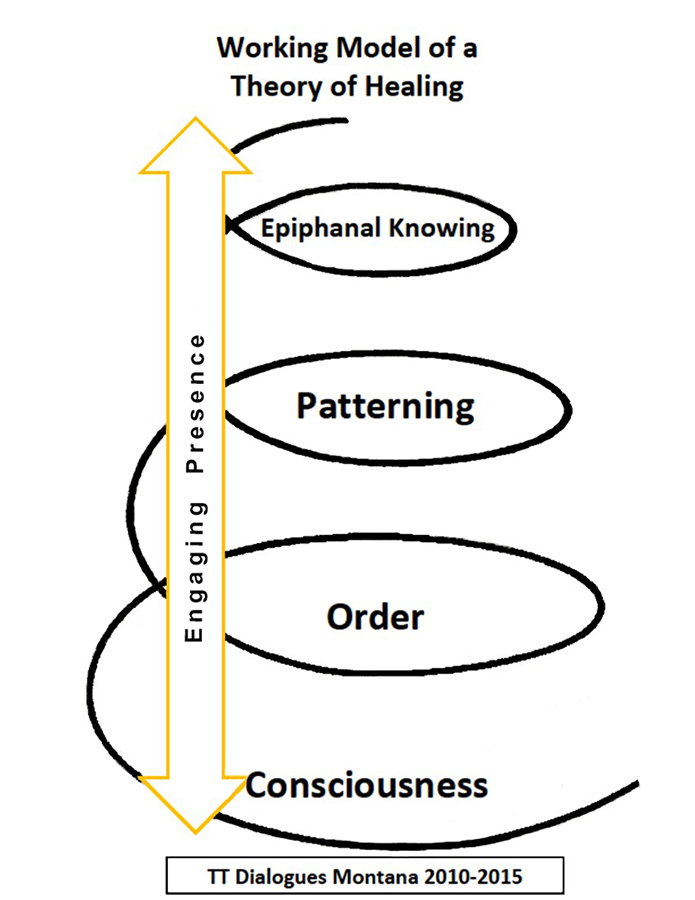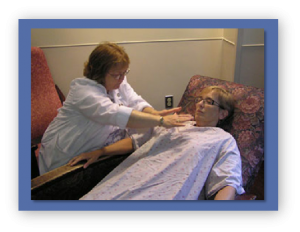The Process of Therapeutic Touch
Therapeutic Touch is based on the idea that human beings are energy in the form of a field. When you are healthy, that energy is freely flowing and balanced. In contrast, disease is a condition of energy imbalance or disorder. The human energy field extends beyond the level of the skin, and the Therapeutic Touch practitioner attunes him or herself to that energy using the hands as sensors.
A Therapeutic Touch treatment is a process that is always individualized and usually does not exceed 20 minutes in length. Your practitioner may ask you to sit in a chair or lie down-whichever is more comfortable for you. It is not necessary to disrobe.
Exact methods vary between practitioners, but generally, they will pass their hands over your body from head to toe, front and back, holding them between 2-6 inches from the skin. This is done to assess the condition of the human energy field. They may use rhythmical, sweeping motions with the hands, as if they are smoothing out wrinkles in your energy field. The practitioner may or may not touch you physically.
Your response is influenced by several factors, such as how long you have been ill, how much your symptoms interfere with your lifestyle, and your general health status.
The Therapeutic Touch Process
The dynamic and interactive phases of Therapeutic Touch process:
- Centering – bringing the body, mind, emotion to a quiet, focused state of consciousness. Centering is using the breath, imagery, meditation and/or visualizations to open one’s self to find an inner-sense of equilibrium to connect with the inner core of wholeness and stillness.
- Assessing – holding the hands between 2 to 6 inches away from the individual’s body while moving the hands from the head to the feet in a rhythmical, symmetrical manner. Sensory cues such as warmth, coolness, static, blockage, pulling, tingling are described by some practitioners.
- Intervention – Clearing also called unruffling – facilitating the symmetrical flow of energy through the field. Unruffling is achieved by using hand movements from the midline while continuing to move in a rhythmical and symmetrical manner from the head to the feet.
- Balancing, Rebalancing – projecting, directing and modulating energy based on the nature of the living field; assisting to re-establish the order in the system. Treatment is accomplished by moving the hands to the areas that seem to need attention – energy may be transferred where there is a deficit or energy may be mobilized or repatterned from areas of congestion.
- Evaluation/Closure – finishing the treatment – using professional, informed and intuitive judgment to determine when to end the session. Reassessing the field continuously during the treatment to determine balance and eliciting feedback from the individual are cues as to when to end the TT treatment.
Shifts in Consciousness that Occur within each Phase of TT
In 2011, Dr. Dolores Krieger invited TT practitioners to participate in a exploration of the experience of practicing Therapeutic Touch. Krieger, Cole & Matheny (2012) published Looking Over My Shoulder: A Study in Mindfulness during Therapeutic Touch. Based on the findings of this study, Krieger described ways in which the Therapeutic Touch practitioner experiences shifts in consciousness during Therapeutic Touch. These shifts inform and are informed by the elements of the Therapeutic Touch process.
Since 2015, TTIA collaborated with Dr. Krieger to integrate the shifts in consciousness within the Therapeutic Touch Teaching Guidelines and to develop resources to aid both teachers and students in appreciating the relationship between the shifts in consciousness and elements of TT. The model provided here illustrates this continuous and dynamic relationship.

The Shifts in Consciousness include:
- A CALL OF COMPASSION for a Healing Partner (Hp), a healee in need, initiates the therapist (TTrx) in the Therapeutic Touch process.
- THE APPROACH indicates the physical, psychodynamic, and subtle energy interactions that occur as the TTrx draws near the Hp. This has come to be referred to as the Psychodynamic Corridor.
- THE OUTREACH follows as the TTrx’s hands reach toward the Hp’s personal fields and the hand chakras (and collateral chakras) are activated as she seeks cues to the subtle energy imbalances of the Hp.
- This merges into THE SEARCH which focuses on how the TTrx is picking up information; e.g., through the TTrx’s hand chakras, solar plexus chakras, heart chakra, etc. It is from this information that the TTrx develops her plan for healing.
- This plan unfolds in the next action, THE REBALANCING phase. In this phase the TTrx helps the Hp to regain a balanced state of health, so that it is most often during this phase that the actual healing occurs.
- A final phase, simply called DONE, covers how the TTrx knows that she has done as much as she can for the Hp during that healing session, and she concludes the session.
- A subsidiary phase, THE RECALL, notes ways the TTrx may remember the Hp and his healing session in dream, reverie or other subtle aspects of memory. After validating this information as well as she can, and if it in the Hp’s best interests in reference to his health, she might add this information to the data concerning their TT sessions.
A Theory of Healing
A Theory of Healing: A Practice Based Theory through Therapeutic Touch
In 2010, Dr. Dolores Krieger, invited Therapeutic Touch practitioners and teachers to convene for the Therapeutic Touch Dialogues in Columbia Falls Montana. During the first Dialogues, she invited the attendees to explore the potential for developing a Theory of Healing.
Therapeutic Touch is a uniquely human approach to healing. Between 2010 and 2015, members of the Therapeutic Touch community participated in the development of a practice-based theory of healing through Therapeutic Touch. Through a process of reflective dialogue and constant narrative analysis, the participants revealed the meaning of healing within the context of their TT practice. The theory of healing that emerged highlights the relationship between practitioner and healing partner. Theoretic assumptions and major concepts were identified and refined over time. The model provided illustrates the relationship and the movement between and among the major concepts underlying the theory of healing. The article, A practice-based theory of healing through Therapeutic Touch, authored by Mary Anne Hanley, Denise Coppa, and Deborah Shields, was published in 2018 by the Journal of Holistic Nursing. TTIA has integrated the Theory of Healing within its Therapeutic Touch Teaching Guidelines.


